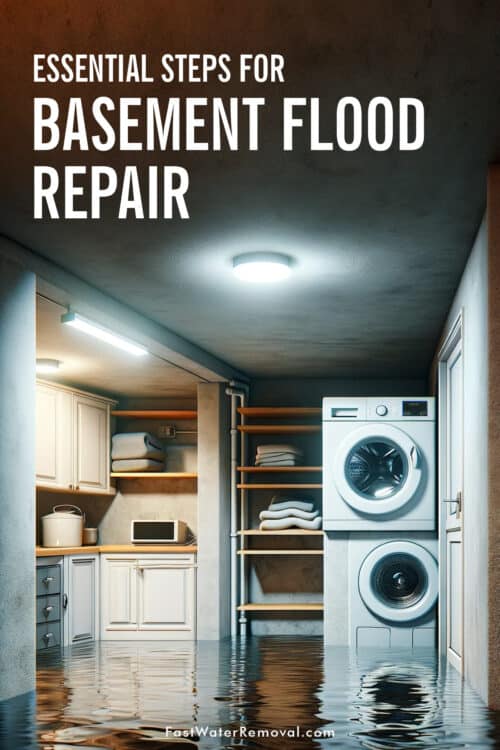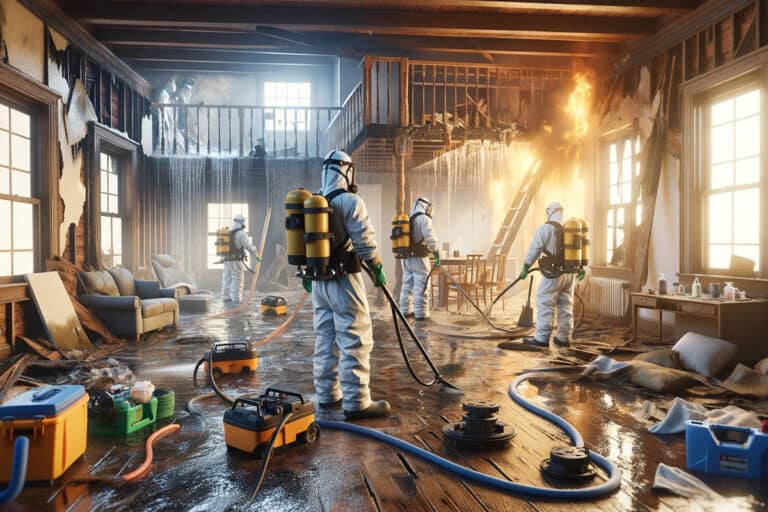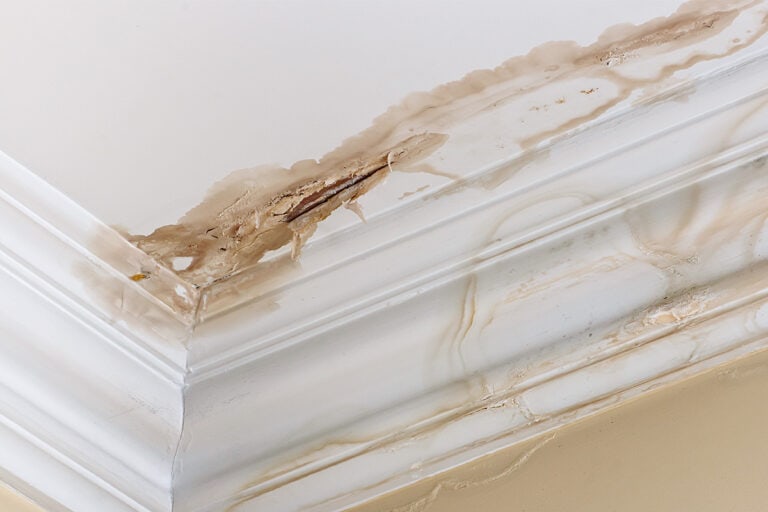Disclosure: I am compensated for purchases made through some links on this site. Click for details.
Dealing with a flooded basement can be a daunting experience for homeowners. It is crucial to address the issue promptly to prevent further damage to the home’s structure and to mitigate the risk of mold and mildew growth. Recognizing the signs of basement flooding and understanding the immediate steps to take can save valuable time and reduce the scope of repairs.
Once the immediate emergency is handled, seeking professional flood repair services becomes the next step to restoring the basement’s condition. These specialized services help in not only cleaning and reconstructing the affected areas but also in implementing preventative measures. Steps like basement waterproofing are essential to safeguard against future occurrences and maintain the integrity of the home.
Key Takeaways
- Swift action is key in minimizing the impact of basement flooding.
- Professional services ensure thorough repair and future prevention.
- Effective waterproofing helps protect basements from subsequent flooding.
Understanding Flooded Basements
When dealing with a flooded basement, recognizing the cause, signs, and extent of damage is crucial for effective management and repair. This knowledge helps homeowners make informed decisions about remediation and prevention measures.
Common Causes of Basement Flooding
Basements can flood due to several factors, often related to water management around the property. Heavy rainfall and storms are frequent culprits, overwhelming drainage systems and leading to water intrusion. Burst pipes, another common issue, can swiftly cause significant damage. Additionally, sewage backups and clogged gutters are potential hazards that may result in flooding, especially during or after a natural disaster.
Recognizing Basement Flood Signs
Early detection of basement floods can minimize long-term damage. Key indicators include water stains on walls, a musty odor indicating mold growth, and standing water, which points to a breach in waterproofing. Homeowners should inspect their basements regularly, especially after storms or heavy rainfall, for these telltale signs.
Evaluating the Extent of Damage
To assess the extent of damage caused by a basement flood, one must consider the depth and area of standing water, as well as the duration of exposure. Waterlogged items and structural elements require immediate evaluation to prevent mold and structural degradation. Professional services can provide a comprehensive inspection and, if necessary, a free estimate.
Emergency Steps to Take
When a basement floods, immediate action is crucial to mitigate damage and ensure safety. The process involves a series of steps ranging from securing the area to documenting the damage for insurance purposes.
Safety Precautions
The safety of residents is paramount during a flooded basement cleanup. They should start by cutting off electricity to prevent electrical hazards. Wearing protective clothing, such as rubber boots and waders, is recommended to guard against contaminants in the water.
Initial Water Removal
Once the area is deemed safe, the next step is to begin removing water. If safe to do so, homeowners can use pumps or wet vacuums for water extraction. However, if the water level is significant or if there are concerns about the structural integrity of the home, they should contact a professional immediately.
Documenting the Damage for Insurance Claims
Documenting the damage is essential for filing a flood insurance or homeowners insurance claim. Individuals should take clear, well-lit photographs of all damages before any cleanup begins. Keeping a detailed inventory of lost or damaged items, alongside any receipts, will provide a robust foundation for the insurance claim process.
Water Damage Mitigation
When a basement floods, immediate action is critical to prevent further damage. The focus should be on mold prevention, moisture control, and the recovery of affected items to mitigate the damage efficiently.
Mold and Mildew Prevention
The presence of moisture makes basements an ideal environment for mold and mildew growth. Mold remediation efforts should start within 24-48 hours of water exposure to prevent mold spores from proliferating. Immediate steps include removing water-soaked materials and applying antimicrobial treatments to affected surfaces.
Dehumidification and Air Circulation
To stabilize the environment and prevent mold, high-capacity dehumidifiers are essential in extracting moisture from the air. Additionally, using air movers to promote circulation assists in the evaporation of water from structural elements and personal belongings. Continuous air movement not only speeds up drying but also hinders mold growth.
Damage Control and Salvage Operations
Assessing the extent of water damage and determining which items are salvageable is a delicate process. Non-porous items can often be cleaned and disinfected, but porous materials may require disposal. Specialists use a variety of techniques to restore water-damaged items, giving preference to items of high value or importance.
Professional Flood Repair Services
When a basement floods, it is critical to promptly engage a professional to mitigate the damage and restore the property. Experts in water damage restoration can help homeowners navigate the complexities of flooding, ensuring that repairs are thorough and long-lasting.
Choosing the Right Restoration Specialist
Finding the right restoration specialist is paramount, as it affects both the immediate and long-term condition of the home. Homeowners should look for certified professionals with a strong track record, ensuring they are equipped to handle a range of flood-related issues. It is advisable to consider local foundation experts who understand the region’s specific challenges and regulations.
Water Damage Restoration Process
The water damage restoration service process typically begins with an in-depth assessment, where professionals will evaluate the extent of the damage. Following the initial review, they will extract the water, dry the affected areas, and then clean and sanitize to prevent mold growth. A plumber may be involved to address any plumbing failures that could have caused or contributed to the flooding.
Assessing Long-term Repair Solutions
To prevent future incidents, long-term repair solutions are assessed and may include foundation repair or reinforcement. Homeowners need to consider these options carefully, with recommendations from trusted professionals that can range from installing a sump pump to sealing basement walls. Hiring a pro can guarantee that the decisions made will safeguard the home against subsequent water damage.
Basement Waterproofing and Prevention
To ensure a dry basement, homeowners need to focus on comprehensive solutions that address water infiltration and manage internal moisture levels. A multi-faceted approach includes improving exterior drainage, installing reliable sump pumps, repairing foundational flaws, and adopting ongoing preventive strategies.
Improving Drainage and Repelling Water
One of the first steps in preventing basement flooding is to enhance the drainage system around the property. This often involves grading the landscape slope away from the foundation to ensure that water does not pool against basement walls. Additionally, extending downspouts and keeping gutters clean can divert rainwater effectively, mitigating the risk of infiltration. Proper drainage is critical in safeguarding the basement from water damage.
Sump Pump Installation and Maintenance
A sump pump is a vital component in a basement waterproofing system, actively removing accumulated water from the basement. It’s crucial to choose the correct sump pump size for your space and to install a backup sump pump for added security during power outages. Regular maintenance ensures the equipment will function as expected when it’s most needed, especially during heavy rainfall.
Foundation and Structural Repairs
Over time, a building’s foundation may develop cracks that allow water to enter the basement. It’s critical to seal any foundation cracks promptly and to consider internal and external waterproofing methods to waterproof basement walls. For significant structural issues, professional assessment and repairs may be necessary to prevent further water damage and to maintain the integrity of the home.
Preventive Measures and Tips
Though some basement waterproofing costs can be significant, taking preventative measures can save homeowners from more extensive repair expenses down the line. Simple actions, such as sealing windows and doors, using water-resistant paint, and inspecting plumbing for leaks, are essential steps in waterproofing your basement. Regular inspections can help homeowners identify potential problem areas early and prevent basement flooding before it begins.
Financial Considerations
When facing the aftermath of a basement flood, homeowners should be informed about the various expenses involved and the avenues for financial relief. It is crucial to understand not only the immediate repair costs but also the longer-term investments for protection and the potential support from insurance and warranty plans.
Costs of Basement Flooding Repair
Repair costs for a flooded basement can vary widely, with some homeowners spending around $500 for minor damage and others facing bills of up to $50,000 for extensive repairs. Factors influencing cost include the depth and type of water, the extent of damage, and the required restoration services. As reported by Forbes, the average homeowner may pay approximately $4,300 for basement flooding repair.
Understanding Insurance Coverage
It’s important for homeowners to review their insurance policies to determine if basement flooding is covered. Most standard homeowners’ insurance policies do not include flood damage, necessitating a separate flood insurance policy typically offered through the National Flood Insurance Program. When a flooding incident occurs, contacting the insurance company quickly to file an insurance claim is essential to receiving timely assistance.
Investing in Basement Flood Protection
Proactive measures can be a wise investment to reduce the likelihood of future flooding. These may include installing a sump pump, proper landscaping, or sealing basements. Although initial costs might seem high, many homeowners find that investing in such flood protection measures can lessen the financial burden from potential future damages and can also be positively reflected in flood insurance premiums.
Maximizing Home Warranty Benefits
Some homeowners may have a home warranty that covers certain repairs or replacements not usually included in standard insurance policies. Homeowners should check their home warranty details to understand what is covered and the process of lodging a claim. This can sometimes offset the cost of repairs or replacements for systems implicated in the flooding, such as sump pumps or plumbing.
Cleaning and Reconstruction
After a basement flood, timely cleaning and meticulous reconstruction are essential to prevent mold growth and structural damage. A systematic approach to cleaning and the selective replacement or repair of damaged materials can restore the basement to its pre-flood condition.
Basement Cleaning Steps
- Remove Water: Quickly extracting standing water is critical. Use submersible pumps and wet vacuums for larger volumes of water.
- Sort and Clean: Separate damaged items. Carpets and furniture can often be salvaged with thorough cleaning and disinfecting.
- Dry Out: Industrial fans and dehumidifiers can facilitate the drying process. Ensure the space is dry to prevent mold.
Restoring Damaged Walls and Flooring
- Inspect and Remove: Evaluate the walls. Drywall absorbs water and may require cutting out the damaged portion.
- Disinfect: Areas affected by floodwater should be disinfected to eliminate mold and bacterial growth.
- Flooring: Examine the subflooring for damage. Replace materials like laminate or hardwood when necessary.
Electrical and Plumbing Work
- Safety First: Always ensure the power is off before inspecting electrical outlets. Hire a licensed electrician for repairs.
- Plumbing Checks: Inspect for leaky pipes, which might have contributed to the flood. A professional plumber should address any issues.
- Restoration: Replace any damaged electrical fixtures and ensure the plumbing system is fully functional before finishing the reconstruction.
Personal Safety and Health
When dealing with a flooded basement, it is critical to prioritize personal safety and health. Potential hazards include exposure to mold, harmful bacteria, and compromised structural integrity. Taking proper precautions can prevent serious health issues and long-term damage to your property.
Recognizing Hazards in a Flooded Basement
In a flooded basement, hazards such as electric shock, contaminated water, and unstable flooring are prevalent. One should shut off the power and gas to the area to mitigate the risk of electrocution or explosions. Mold and mildew can develop within 24 to 48 hours of flooding, thriving in humidity and creating a health risk if not promptly addressed.
Proper Use of Disinfectants and Safety Gear
Cleaning a flooded basement requires the use of effective disinfectants to eliminate pathogens. One should use protective clothing, including gloves, goggles, and a face mask or respirator, to safeguard against the inhalation of spores and contact with contaminated materials. It’s important to ventilate the area well and follow the manufacturer’s instructions when applying anti-mildew spray and other cleaning agents.
Long-term Health Risks from Basement Floods
Exposure to damp and moldy environments may lead to respiratory problems and allergic reactions. Consistent high levels of humidity can allow mold to persist, creating long-term health risks. To prevent these issues, one should address any moisture problems promptly and monitor the basement for signs of mold after remediation.
Conclusion
Managing a flooded basement effectively involves swift action and professional assistance. Homeowners must address safety, water removal, and damage assessment quickly to mitigate the impact. Long-term prevention, like professional waterproofing, is crucial to protect against future incidents.
Understanding basement flood causes and early signs is key to reducing risks. Immediate preventative measures can significantly minimize damage. Being informed about insurance and financial considerations ensures efficient and cost-effective repairs.
A proactive approach to flooding saves time, money, and stress, ensuring property safety and integrity. Homeowners should prioritize regular maintenance and expert advice for long-term protection. This strategy helps maintain a safe, dry, and secure home environment.






